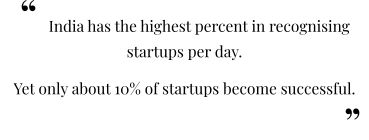Effective Product Launch Strategies
Lessons Learned from Startup Case Study
We are in the midst of the dust of rocket launching missions and competitions. In the
entertainment industry, it is celebrities, starkids, pop stars and musicians that they launch. In the
commercial market of today, on average, about 137,000 startups are launched every day.
The possibility is vast, the potential is immense and innovation knows no bounds in the capitalist
era. India has the highest percent in recognising startups per day. Yet only about 10% of startups
become successful. That is why in today’s dynamic and competitive business environment, the
art of introducing a product to the market has grown into a multidimensional science.
Welcome to the world of “Product Launching Strategies,” where creativity and strategy combine to create a success symphony. This journey delves into the meticulous orchestration of ideas, timing, and consumer insights, all aimed at not just unveiling a product, but crafting an unforgettable narrative that captivates the audience and propels the brand towards triumph. Join us as we unpack the complexities, look into case studies, and investigate the wide range of ways that convert product launches into resounding success stories.
Welcome to the world of “Product Launching Strategies,” where creativity and strategy combine to create a success symphony. This journey delves into the meticulous orchestration of ideas, timing, and consumer insights, all aimed at not just unveiling a product, but crafting an unforgettable narrative that captivates the audience and propels the brand towards triumph. Join us as we unpack the complexities, look into case studies, and investigate the wide range of ways that convert product launches into resounding success stories.

What Does it Really Mean by Product Launch
A product launch initiates the introduction of a new product into the market employing
certain strategies and stabilizing the growth of the product thereon. It is a process that
requires diligent planning and SWOT analysis. It is imperative that a well-studied product launch
contains all the possible outcomes and reactions to the release- of that of the market, competitors,
general public and the target consumers. The review of the product will be premeditated in
successful product launch in such a way that the anticipation can be avoided.
An effective product launch thus, needs meticulous planning, smart execution, and constant monitoring. Here’s a step-by-step guide to help you get started. Don’t worry if this goes over your head, we will delve deep into the process posing an example. While you read, try answering this riddle:
“I come in colors or simply colorless. I’m not paper or metal, I’m somewhere between. I carry easy but perish so hard. On land and in waters, I cause quite some harm. Who am I?”
An effective product launch thus, needs meticulous planning, smart execution, and constant monitoring. Here’s a step-by-step guide to help you get started. Don’t worry if this goes over your head, we will delve deep into the process posing an example. While you read, try answering this riddle:
“I come in colors or simply colorless. I’m not paper or metal, I’m somewhere between. I carry easy but perish so hard. On land and in waters, I cause quite some harm. Who am I?”

The EcoKaari Effect
Did you guess the answer to the riddle above?! Well, this nature-loving entrepreneur sure did!
Nandan Bhat, who saw the regressing state of the hills that he usually trek on realized how, since plastic wrappers and bags did not fetch any bucks for the collectors, plastic waste was slowly erasing the identity of what is nature and leaving a footprint that was anything but natural and irreversible to an extent. After several attempts to get his vision through, Bhat would finally see the light in 2020 with Ecokaari, a Pune based social enterprise that thrives in a revenue of 8 lakh per month and is a proud mitigator of 20 million plastic bags from landfills. Focused on upcycling plastic debris into beautiful handcrafted products, EcoKaari is much more than a business, it is a reparation of the past, a message to the present and a model for the future with special attention given to handcrafting and handweaving the products.
Nandan Bhat, who saw the regressing state of the hills that he usually trek on realized how, since plastic wrappers and bags did not fetch any bucks for the collectors, plastic waste was slowly erasing the identity of what is nature and leaving a footprint that was anything but natural and irreversible to an extent. After several attempts to get his vision through, Bhat would finally see the light in 2020 with Ecokaari, a Pune based social enterprise that thrives in a revenue of 8 lakh per month and is a proud mitigator of 20 million plastic bags from landfills. Focused on upcycling plastic debris into beautiful handcrafted products, EcoKaari is much more than a business, it is a reparation of the past, a message to the present and a model for the future with special attention given to handcrafting and handweaving the products.
How EcoKaari Collected Momentum
Bhat’s way forward was something like this:
- EcoKaari conducted market research and identified its target audience over a decade.
- Bhat invested 20 lakhs to identify and connect a problem to both profits and social gains.
- With five years of prior experience in a similar business model, Bhat easily developed and launched the product.
- The mantra was simple- Upcycling! Collaborating with corporates, local and regional NGOs, plastic waste collection was made easy.
- The cleaning, segregating, refining, cutting, and spinning process was organized to produce items like bags, pouches, cushion covers, laptop sleeves, and more.
- We targeted potential customers through campaigns, social media ads, and eco-sensitive “raw material” suppliers.
- Ecokaari trained and assisted the local craftsmen using spinning wheels and handlooms who were deprived of work.
- The message and goals were crystal clear: upcycling, supporting local artisans, and empowering marginalized women were their top priorities.
Achieved Targets and Achievable Aspirations
The business today stands at international corridors with supplies being couriered from overseas,
order from corporates amounting to 60 percent of the sales, resellers selling under EcoKaari
brand and a band of loyal customers online, with a desirable turnover of Rs. 1 crore for the
year. All of this, in less than two years. Evaluating the market conditions, EcoKaari found space
to fill its predecessor’s mistakes and found channels to keep it afloat amongst the competition.
Bhat envisions a near future where he can generate employment for thousands of underprivileged citizens and upcycle 100 tonnes of plastic waste every month. Given their marketing strategic layout, which realizes the scope of their work socially, economically and ecologically and is gathering more momentum each day, such a goal is surely desirable and possible.
Bhat envisions a near future where he can generate employment for thousands of underprivileged citizens and upcycle 100 tonnes of plastic waste every month. Given their marketing strategic layout, which realizes the scope of their work socially, economically and ecologically and is gathering more momentum each day, such a goal is surely desirable and possible.
Conclusion
Plastic is the answer- to the riddle, to the rampant decline of the environmental conditions, to
your laziness and to the synonyms for harm. Any sound industry has to be eco friendly by
default, owing to the era that we are in. Ranging from climate change, natural degradation,
ecological mishaps, ocean health decline to global warming and ozone layer depletion, all have
direct or indirect connection to globalization and the introduction of plastic into daily lives.
Identifying this in the business model was EcoKaari’s success.
Hold your product close, but your launching strategies closer!

Products that have social relevance are obviously easier to market. But what about the
products which were marketed rigorously despite being harmful? That is why they say, there are
no wrong products, only failed marketing strategies. Just like how scientists work months in
research before they launch a satellite, a product must be studied to analyze it’s pulse, it’s impact,
the chances of a washout and the tools to keep it afloat and driving in the space until its ready to
be uncurtained and unleashed into the wider space.
Hold your product close, but your launching strategies closer!





